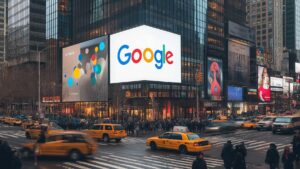What are paid ads?
Paid ads are onlineWerbeanzeigenAdvertising is a form of advertising for which an advertiser pays to place its marketing messages on various platforms such as search engines (e.g. Google Ads), social media (e.g. Meta or TikTok Ads) or display networks (banner ads).
They are a very direct, immediate way to run measurable marketing campaigns. For example, goals such as awareness, traffic, leads or conversions (e.g. purchases) can be achieved.
Paid ads can be roughly divided into four areas.
SEA (search engine ads)
SEA stands for Search Engine Advertising (search engine marketing) and, as the name suggests, plays a role in the field of search engines. In concrete terms, this means placing ads in classic web search engines such as Google or Bing. This is possible in text form as well as in the form of images or videos. In addition to the classic web search engines, search engines such as YouTube (video search engine) or Amazon (product search engine) can also be relevant for SEA. YouTube advertising, for example, can be booked via Google Ads.
Social Ads
Social ads are placed specifically in social networks such as Facebook, Instagram, TiktTok, LinkedIn, X and others. In addition to the organic content, the ads are displayed to users in the feed, in the stories or in the reels.
Display Ads
Also known as banner advertising, display ads are graphic forms of advertising that are displayed on websites, in social media or in apps. They are used in both SEA and social ads, but still count as a separate category.
Native advertising
Native advertising describes advertising in the environment of editorial content. They are difficult to distinguish from editorial articles, as they are embedded in them and the transitions are sometimes fluid. There are advertising platforms through which native advertising can be booked. In some cases, however, this is also traditional media business in media companies.
Advantages & disadvantages of paid ads
Where there is light, there is also shadow. While there are certainly some advantages to relying on paid ads in online marketing, the format also has disadvantages for advertisers.
✅ Advantages of Paid Ads
Fast visibility
Ads go live immediately and deliver fast results.Addressing specific target groups
Precise targeting by interests, demographics, location and behavior possible with some platforms primia.Good measurability & optimization
Clearly measurable KPIs (CTR, CPC, ROAS) give me quick feedback on whether my campaign is working - or not. I can react and optimize accordingly.Controlled budgets
Advertising budgets can be used flexibly and in a targeted manner.Remarketing & Retargeting
Targeted addressing of users who have already had contact with the brandn.High scalability
Measures can be easily raised and lowered as required.
⚠️ Disadvantages of Paid Ads
Cost-intensive
Depending on the platform, industry and competition, the costs can be very high. For example, ads on LinkedIn are more expensive than on Google Ads. It is important here to always keep an eye on the ROAS.Short-term effect
As soon as the campaigns pause, my visibility ends immediately.Complexity & necessary expertise
Running paid ads campaigns requires knowledge, experience and ongoing support, otherwise a lot of money will be burned very quickly.
Paid ads always make sense in the online marketing mix. Those who combine paid ads with organic online marketing activities such as SEO or organic social has also been proven to increase the performance of its paid ads.
Select the right Paid Ads channel
All paid ads channels reach target groups in different ways and have different effects.
When selecting the right channel for paid ads, three key questions can be used as guidelines:
- Where can I reach my target group (users)?
- What are my goals?
- Is a push or pull channel more suitable?
If I have a young target group, for example, a social media platform such as TikTok can be relevant. In the B2B environment, LinkedIn is of course a good choice. But a businessman also hangs around on Instagram in his private life.
If I want to sell my products, such as a webcam, product searches such as Amazon or Google Shopping to.
In other cases, however, I have to create demand first, as there is no demand for my innovation yet. New technologies or services are better placed via push channels.
Push vs. pull with paid ads
The classic push-pull perspective from marketing theory can be perfectly applied to paid ads. Roughly speaking, they can be categorized as follows:
- Push: Social, display, video, native ads
- Pull: Search Ads
With pull ads, the user actively searches for something, they have a clear need. For example, they go to Google and type in the search term "Google Ads agency". We can then place ads there above the organic search results.
All forms of advertising have one thing in common: they must be labeled. This is why they can be recognized by additions such as "Advertisement" or "Sponsored" in Google search results. Let's get straight to the point: With paid advertising, content, products or even services can be shown to exactly the right people, exactly when they should see it. In terms of structure, they are indistinguishable from organic results apart from the aforementioned addition, but ideally they address the search term in more detail and have a clear call to action.
What can I achieve with online advertising?
A crucial question here is "What are my goals?". The following goals can be achieved with paid ads on Google, Meta and Co:
- Make the company even better known?
➡️ Create awareness: Increase brand visibility and reach the relevant target group. - More customers on your own Website lure?
➡️ Generate traffic: Drive more traffic to the website to attract potential customers. - Encourage potential customers to buy?
➡️Umsatz increase: Promote sales and increase turnover through targeted ads. - Get in touch with the right target group (e.g. via whitepaper downloads, newsletter subscriptions)? Generate ➡️Leads: Collect qualified contacts through whitepaper downloads or newsletter registrations, for example.
- Increase app installations?
➡️ App advertising: Increase the number of app installations - More customer visits to the store?
➡️ Local store visits: Increase the number of visitors to your store
It is always important that the goals are measurable, e.g. increase website traffic by 10 % in 3 months. It is also crucial to continuously and carefully monitor and adjust the ads after launch. Relying on a one-off campaign launch is not enough. Intensive optimization is essential, especially in the first few weeks. However, advertising campaigns must also be regularly updated in the long term. This is the only way to ensure efficient targeting.
The world of paid ads is vast - overview of the various platforms
In addition to the question "What are my goals?", you also have to ask yourself "Where is my target group active?" and "Where are they searching?". There is no template that can be applied to all companies on the platforms. Every ad is as individual as a tailor-made suit, which is the only way to effectively avoid unnecessary wastage.
Search engines:
- Google (still clear market leader)
- YouTube (second largest search engine in the world - measured by the number of search queries)
- Bing
- Yandex (Russia)
- Baidu (China)
- Amazon (Products)
- ... many more
Paid ads for social media:
- YouTube
- TikTok
- Snapchat
- X (formerly Twitter)
Native, SSPs & other platforms:
- Taboola
- Outbrain
- Yahoo Gemini
- Spotify
- Mistplay
- ReklamStore
- Triplelift
- MGID
- and many many more
Enter the world of paid ads!
Paid ads are a powerful tool in the digital marketing mix. They offer companies the opportunity to address their target groups precisely and achieve clearly defined marketing goals. The advantages, such as rapid visibility and measurable results, are offset by potential disadvantages such as costs and potentially fierce competition. The world, and the online world in particular, never stands still. So has dhe integration of artificial intelligence (AI) is revolutionizing paid advertising. This is because the use of AI makes it possible to create personalized advertising for a precise target group approach and to optimize campaigns in real time. Google Ads, for example, enables the automatic generation of content and image suggestions and displays recommendations for optimizing campaigns. All adjustments are implemented in real time. The need for manual adjustments is minimal and efficiency is increased at the same time.
In short: Paid ads are much more than just placing ads - they are an investment in targeted reach and measurable results that, when used correctly, create a decisive competitive advantage.
You don't yet know exactly whether and how the journey should start? We're here to help and guide you on the path to success with digital advertising. Arrange a free strategy meeting directly with one of our senior consultants.



